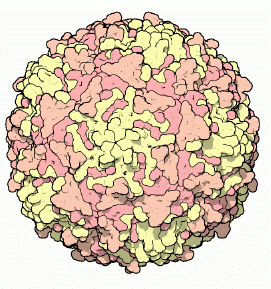The beginning of the end for Polio
What does it look like?

The Polio virus, from structure 2PLV in the PDB image by David Goodsell http://mgl.scripps.edu/people/goodsell/ for the RSCB PDB http://www.rcsb.org/pdb/home/home.do.
What is it?
Today marks the anniversary of the first mass inoculation of children against polio. In 1954 children in Pittsburgh were inoculated using a vaccine developed by Jonas Salk. In 1988, based on the success of Salk's and subsequent vaccines the World Health Organisation began the campaign to eradicate Polio. They are very close to achieving this – success will mean that polio will be only the third disease, after smallpox and rinderpest, to be eradicated in humans.
The polio virus is a Picornaviruses, or "little RNA virus", and attacks cells by binding its outer protein shell to them, whist using the small amount of RNA it holds within the shell to replicate itself. Picornaviruses are a common type of virus to affect human health, as they include rhinovirus which causes the common cold. Picornaviruses and their crystal structures were featured by the PDB as their 'molecule of the month', where you can read more on them.
Where did the structure come from?
The structure of the polio virus was found by Filman et al. in 1989, which is entry 2PLV in the Protein Data Bank.






